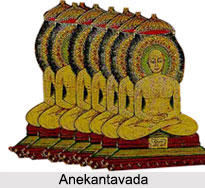 Anekantavada is a central thought of Jainism. It can be translated a as a theory of Non-Radicalism, Non-Absolutism, Non-One-Sidedness, Manifoldness and many other terms. It is a philosophy of synthesis-a reconciling approach towards various Ontological theories of ancient India.
Anekantavada is a central thought of Jainism. It can be translated a as a theory of Non-Radicalism, Non-Absolutism, Non-One-Sidedness, Manifoldness and many other terms. It is a philosophy of synthesis-a reconciling approach towards various Ontological theories of ancient India.
Etymology of Anekantavada
The term Anekanta is used to denote the Jain view of reality. In this sense, the term consists of the two terms, viz. "Aneka" (many, more than one) and "Anta" (qualities, attributes or ends).
The Jains believe that reality is manifold and each entity has a manifold nature. Thus Anekantavada is the theory of manifoldness of reality. Anekantavada emphasizes that reality cannot be expressed in just one way; there are multiple aspects to it.
History of Anekantvada
The origins of Anekantavada can be traced back to the teachings of Lord Mahavira, the 24th Jain Tirthankara. Lord Mahavira is usually regarded as the original profounder of the Anekanta Doctrine. It is well-known that the doctrine of Ahimsa holds supreme importance in the Jain tradition. Mahavira expanded this doctrine of Non-violence from the sphere of practical behavior to the sphere of intellectual, epistemological and philosophical discussion. Thus, the principle of "respect for other views" emerges from the principle of "respect of other life". It is a doctrine that is characterized by toleration, understanding and respect for the views of the others. It is a unique character of the Jain Philosophy and Religion.
Methodology of Anekantavada
In carrying out the function of philosophical methodology, Anekantavada relies upon 2 principles; namely Nayavada and Syadvada.
1. Nayavada: Nayavada recognizes that non omniscient knowledge claims are always limited by a particular stand point on which they are based. Nayavada supports the metaphysical sense of Anekantavada as a way of thinking about the existence of simultaneously both being and becoming. It demonstrates how opposing views are one sided and limited because they are based on limited number of stand points.
2. Syadvada: Syadvada recognizes that all knowledge claims need to be qualified in various ways because of many sidedness of reality and the limitation of any given stand point of knowledge. Syadvada grounds and supports Anekantvada in explaining how a statement about something that is permanent, remaining identical over the time and that is simultaneously in permanent, becoming something else, can be true.
Application of Anekantavada
The application of the Anekantavada enables to understand the various dimensions of truth, to reconcile the apparently contradictory views and facilitates the attitude of respect for other people"s point of view. Anekantavada brings to light the partial truth of all expressed theory and prescribes the reconciling approach towards them in order obtain the comprehensive idea of truth.




















